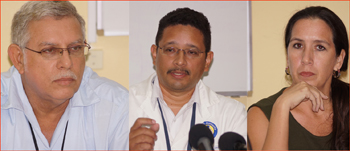
 The Karl Heusner Memorial Hospital’s Board Chairperson, Chandra Cansino; Chief Executive Officer, Dr. Gary Longsworth and Chief of Medical Staff, Dr. Adrian Coye held a press conference on Wednesday, May 22nd to address the death of 12 babies at the KHMH’s Neonatal Intensive Care Unit (NICU). According to a release from the hospital, the 12 babies were delivered at the KHMH and referred to the NICU. One of the children died within two days of birth will the 11 others within 7-27 days of birth.
The Karl Heusner Memorial Hospital’s Board Chairperson, Chandra Cansino; Chief Executive Officer, Dr. Gary Longsworth and Chief of Medical Staff, Dr. Adrian Coye held a press conference on Wednesday, May 22nd to address the death of 12 babies at the KHMH’s Neonatal Intensive Care Unit (NICU). According to a release from the hospital, the 12 babies were delivered at the KHMH and referred to the NICU. One of the children died within two days of birth will the 11 others within 7-27 days of birth.
During the press conference, CEO Longsworth pointed out that the management of the hospital only became aware of the abnormal deaths after the father of one of the children approached the media to complain about the death of his child and at least five others. Since the report, the KHMH launched an investigation into the deaths on Monday, May 20th by a team comprised of the Ministry of Health, Quality Assurance and the Medical Directorate of the hospital.
According to Chief of Medical Staff, Dr. Adrian Coye, the investigation has so far determined that 7 of the 12 deaths have been positively identified as having been caused by an organism called Enterobacter Cloacae. This is a bacterium which causes infections in the lower respiratory tract, skin and soft tissues. The other deaths, said Coye were as a result of the babies having been born prematurely. According to Coye, when the deaths began to occur, the hospital put in place procedural changes and treatment for the children; however, this was not enough to save the lives. The bacterium, according to Coye, is not a superbug and is sensitive to antibiotics, which are available at the hospital. He added that it is unclear how the bug made its way to the NICU but it is transmissible through both direct and indirect contact and it is readily transmissible. He also noted that it is a fastidious bug. Coye added that the bacterium is not unique to Belize and is present in intensive care units all over the world and the Pan American Health Organization in Washington is sending assistance to deal with the outbreak.
Since the incidence, the NICU unit has been closed but the services are still being offered from the KHMH but these are provided from other areas identified within the hospital. Now, the hospital is focusing on decontaminating and retrofitting the unit, in particular, expanding the clinical area. Also, the authorities are trying to identify if there is a source for the infection. Coye noted that the NICU was built sixteen years ago to accommodate 16 babies but now the demand far exceeds the design. For the time being, the infection has been contained and the unit is being reformatted and procedures are being put in place to mitigate the infection.
Asked if there was a lapse in the reporting process, Chairperson, Chandra Cansino pointed out that with the speed at which the bacterium infected the children, it was difficult to determine what was the cause of the deaths since it takes about 5 days for cultures to be grown to determine what the bug was. During that space of time, babies kept dying. She added that the board held an emergency meeting to have discussions with the staff at the hospital as well as parents of the babies who died and get suggestions and information on how to prevent a reoccurrence. So far, there has been no culpability assigned to anyone for the deaths.



